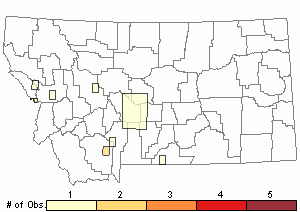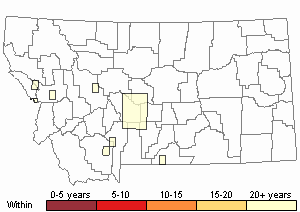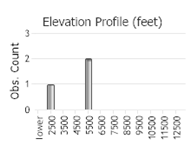View in other NatureServe Network Field Guides
NatureServe
Montana
Utah
Wyoming
Idaho
Wisconsin
British Columbia
South Carolina
Yukon
California
New York
A Dry Rock Moss - Grimmia longirostris
Other Names:
A Black Rock Moss,
Grimmia affinis
General Description
Plants: Compact cushions. Yellow-green to dark olivaceous. Stems 1-3 cm tall. In X-S the stem has a strong central strand.
Leaves: Ovate-lanceolate, 1.5-3.0 x 0.6-0.7 mm, and keeled. Awn 0.5-1.5 mm long, broadly attached and decurrent. One margin proximally recurved. Costa reaches apex.
Leaf Cells: Basal laminal cells near costa are long-rectangular to linear, sinuose, and thick-walled. Basal laminal cells near margin are short-rectangular, straight, thick-walled transversely, thin-walled laterally, and hyaline. Median laminal cells are short-rectangular, sinuose, and thick-walled. X-S: distal laminal and marginal cells are 2-layered and not bulging. Costa X-S: Reniform in outline (keeled).
Diagnostic Characteristics
Grimmia affinis has frequently been considered a subspecies of G. ovalis. However, G. affinis is autoicous, and its leaves have one recurved margin which are keeled narrowly near the tip. G. ovalis, on the hand, is dioicous and has flat leaf margins that are widely concave above (FNA 2007).
Range Comments
Rocky Mountains from New Mexico to the southern Canadian provinces, extending east in the U.S. to Minnesota. Greenland; Canada: AB, BC, MB, NB, NL, NT, NS, NU, ON, QC, SK, YT; USA: AK, AZ, CA, CO, ID, ME, MN, MT, NV, NH, NM, NC, OK, OR, SD, TX, UT, VT, WA, WY; Mexico; Central America; South America; Eurasia; Africa; Pacific Islands; Australia (FNA 20007). In Montana, known from Carbon, Flathead, Glacier, Gallatin, Madison, Mineral, and Missoula Counties (Elliott 2016).
Observations in Montana Natural Heritage Program Database
Number of Observations: 13
(Click on the following maps and charts to see full sized version)
Map Help and Descriptions
Relative Density

Recency



 (Observations spanning multiple months or years are excluded from time charts)
(Observations spanning multiple months or years are excluded from time charts)
Habitat
Exposed, dry, acidic granite and quartzite rock. Low to moderate elevations (330 – 10,200 feet). It is common on the eastern side of the Rocky Mountains.
Reproductive Characteristics
Seta is 1.0-4.0 mm tall, straight, and centrally attached to capsule. Capsules are often found, usually exserted (sometimes emergent), yellow, oblong-ovoid to cylindric. Autoicous.
Gemmae absent on leaves.
Stewardship Responsibility
References
- Literature Cited AboveLegend:
 View Online Publication
View Online Publication Elliott, J.C. and A.K. Pipp. 2018. A Checklist of Montana Mosses (1880-2018). Updated 3 January, 2020. Montana Natural Heritage Program, Helena, Montana. 73 pp.
Elliott, J.C. and A.K. Pipp. 2018. A Checklist of Montana Mosses (1880-2018). Updated 3 January, 2020. Montana Natural Heritage Program, Helena, Montana. 73 pp.
- Additional ReferencesLegend:
 View Online Publication
View Online Publication
Do you know of a citation we're missing? Elliot, J. C. 1993. Second checklist of Montana mosses. Unpublished report. U.S. Forest Service, Region 1. Missoula, MT. 45 pp.
Elliot, J. C. 1993. Second checklist of Montana mosses. Unpublished report. U.S. Forest Service, Region 1. Missoula, MT. 45 pp. Lawton, E. 1971. Keys for the Identification of the Mosses on the Pacific Northwest. Reprinted from 'Moss Flora of the Pacific Northwest'. Published as Supplement No. 2 of the Journal of the Hattori Botanical Laboratory. Nichinan, Miyazaki, Japan. 66 pp.
Lawton, E. 1971. Keys for the Identification of the Mosses on the Pacific Northwest. Reprinted from 'Moss Flora of the Pacific Northwest'. Published as Supplement No. 2 of the Journal of the Hattori Botanical Laboratory. Nichinan, Miyazaki, Japan. 66 pp. Lawton, E. 1971. Moss Flora of the Pacific Northwest. Hattori Botanical Laboratory. Japan: Yamabuki-cho, Shinjuku-ku, Tokyo. 362 pages plus appendices.
Lawton, E. 1971. Moss Flora of the Pacific Northwest. Hattori Botanical Laboratory. Japan: Yamabuki-cho, Shinjuku-ku, Tokyo. 362 pages plus appendices.
- Web Search Engines for Articles on "A Dry Rock Moss"





